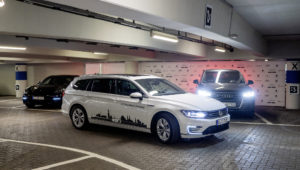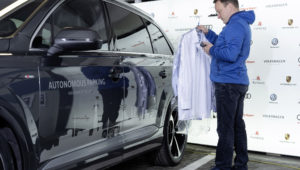Parking at the airport becomes less stressful. That, at least, is how the Volkswagen Group presents itself. The latter is currently testing autonomous parking at Hamburg Airport with its VW, Audi and Porsche brands. On the basis of a car park map, the vehicles navigate independently to the parking spaces assigned to them.
VW wants to make mobility less stressful
“Autonomous parking can make an important contribution to making mobility more comfortable and stress-free for our customers. That’s why we want to democratize the technology and make it accessible to as many people as possible,” says Johann Jungwirth, Chief Digital Officer of the Volkswagen Group, explaining the goal of the new Mobility solution.
How does autonomous parking work?
The function of autonomous parking, which was shown to the public for the first time in Hamburg, is already beyond the research stage. Image markers installed in the car park provide orientation for the vehicles. They have the advantage that they can then be used in any car park. The safety of all occupants and road users in the car park itself has top priority. It is also planned that the first vehicles with this parking technology will be installed in the Group’s brands as early as 2020.
The first test is running at Hamburg Airport
As part of the city partnership between the VW Group and the Free and Hanseatic City of Hamburg, the Volkswagen, Audi and Porsche brands are testing autonomous parking at Hamburg Airport. The different brands rely on their know-how in development and thus want to make the new function ready for series production quickly and across brands. The many years of experience in the development of various parking functions and the current expertise on autonomous functions in the vehicles themselves are therefore important.
Fully automatic loading during parking time by Park & Charge
“Loading robots will contribute to increasing the acceptance of e-mobility in public spaces, possibly even in private spaces,” says Uwe Michael, Head of Electric/Electronic Development at Porsche, adding to the test environment.
This means that the car is not only parked automatically, but also loaded automatically. A visit to a restaurant in the evening, a weekend stroll in the shopping center or a visit to the theatre with the children. Porsche Manager Michael: “At the same time, the capacity utilisation of the charging infrastructure is improved because the car is only on a charging station for as long as it takes to charge”.
Park & Charge works like this: as soon as the electric car or even the hybrid model is fully autonomously parked in a charging station, the vehicle and charging robot communicate via WLAN. The loading flap of the vehicle is opened automatically, the arm of the loading robot approaches and establishes the connection between the power supply and the onboard loader. Afterwards, the vehicle automatically parks in another car park and thus releases the charging station for the next electric car.
The test of autonomous parking carried out in Hamburg shows how the urban mobility of the future will be shaped: new mobility solutions are changing the classic role of the purely technology-oriented automobile manufacturer, new partnerships are emerging and the customer and his needs are thus becoming even more central.
More posts from the category “News”:
Post a Comment
You must be logged in to post a comment.

























